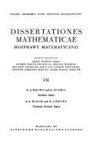cp -半群与膨胀,子积系统与超积系统:多参数情况及其他
IF 0.8
3区 数学
Q1 MATHEMATICS
引用次数: 16
摘要
这些笔记是十年来关于如何利用积系统将单参数cp -半群的膨胀结果推广到d-参数半群及其他半群的研究成果。虽然关于二参数和d参数情况的初步工作是基于Muhly和Solel的CP-map的arveson - stinspring对应(仅限于von Neumann代数)的方法,但在这里,我们将通过Paschke的Bhat和Skeide的CP-map的gns对应来探索该方法。(比较推迟到附录A(iv)。)概括是多方面的,困难往往是巨大的。事实上,我们唯一正确的if- only-if定理是:一个在(对)一个Ore单群上的Markov半群,当且仅当它的gns -子积系统嵌入到一个积系统中时,允许一个满(严格或正规)扩张。早前,已经观察到GNS-(分别是arveson - stinspring)对应形成了子产品系统,主要的困难是将其嵌入到产品系统中。在这里,我们补充说,每一次膨胀都伴随着一个超产品系统(如果膨胀是充分的,就是一个产品系统)。后者可能包含也可能不包含gns子产品系统;如果膨胀强劲,它确实会膨胀——但不仅如此。除了许多积极的结果在很大程度上推动了这一理论之外,我们还为几乎每一个我们无法证明的理想陈述提供了大量的反例。不过,仍有少数问题有待解决。最突出的问题是:是否存在一个允许扩张但不允许强扩张的cp -半群?另一个问题:是否存在一个马尔可夫半群,允许(必然是强)膨胀,但不允许完全膨胀?本文章由计算机程序翻译,如有差异,请以英文原文为准。
CP-semigroups and dilations, subproduct systems and superproduct systems: the multi-parameter case and beyond
These notes are the output of a decade of research on how the results about dilations of one-parameter CP-semigroups with the help of product systems, can be put forward to d-parameter semigroups - and beyond. While preliminary work on the two- and d-parameter case is based on the approach via the Arveson-Stinespring correspondence of a CP-map by Muhly and Solel (and limited to von Neumann algebras), here we explore consequently the approach via Paschke's GNS-correspondence of a CP-map by Bhat and Skeide. (A comparison is postponed to Appendix A(iv).)
The generalizations are multi-fold, the difficulties often enormous. In fact, our only true if-and-only-if theorem, is the following: A Markov semigroup over (the opposite of) an Ore monoid admits a full (strict or normal) dilation if and only if its GNS-subproduct system embeds into a product system. Already earlier, it has been observed that the GNS- (respectively, the Arveson-Stinespring) correspondences form a subproduct system, and that the main difficulty is to embed that into a product system. Here we add, that every dilation comes along with a superproduct system (a product system if the dilation is full). The latter may or may not contain the GNS-subproduct system; it does, if the dilation is strong - but not only.
Apart from the many positive results pushing forward the theory to large extent, we provide plenty of counter examples for almost every desirable statement we could not prove. Still, a small number of open problems remains. The most prominent: Does there exist a CP-semigroup that admits a dilation, but no strong dilation? Another one: Does there exist a Markov semigroup that admits a (necessarily strong) dilation, but no full dilation?
求助全文
通过发布文献求助,成功后即可免费获取论文全文。
去求助
来源期刊
CiteScore
2.80
自引率
0.00%
发文量
8
审稿时长
>12 weeks
期刊介绍:
DISSERTATIONES MATHEMATICAE publishes long research papers (preferably 50-100 pages) in any area of mathematics. An important feature of papers accepted for publication should be their utility for a broad readership of specialists in the domain. In particular, the papers should be to some reasonable extent self-contained. The paper version is considered as primary.
The following criteria are taken into account in the reviewing procedure: correctness, mathematical level, mathematical novelty, utility for a broad readership of specialists in the domain, language and editorial aspects. The Editors have adopted appropriate procedures to avoid ghostwriting and guest authorship.

 求助内容:
求助内容: 应助结果提醒方式:
应助结果提醒方式:


